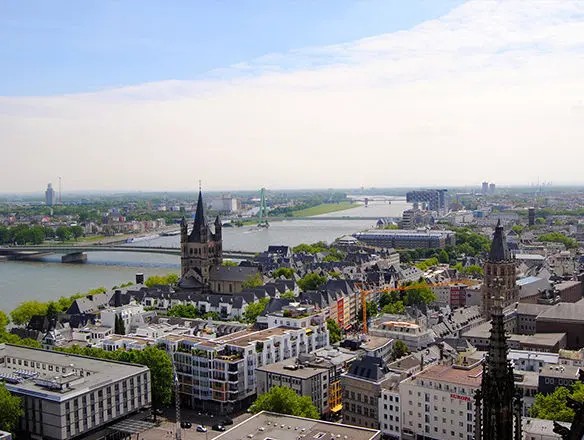
Audio file 1: Introduction
Cathedral and Carnival! These two keywords probably come first in everyone's mind whenever they think of Cologne. Both are undoubtedly among the city's highlights, though they are by no means all that the Rhine metropolis has to offer.
Germany's fourth-largest city looks back on more than 2000 years of history, the traces of which can be seen all over the city. Imposing buildings, fascinating museums and, of course, the typical Cologne lifestyle - in Cologne, there is something to explore on almost every street corner.
Let us start the tour with our audio guide at the most famous landmark of Cologne - the Cologne Cathedral.
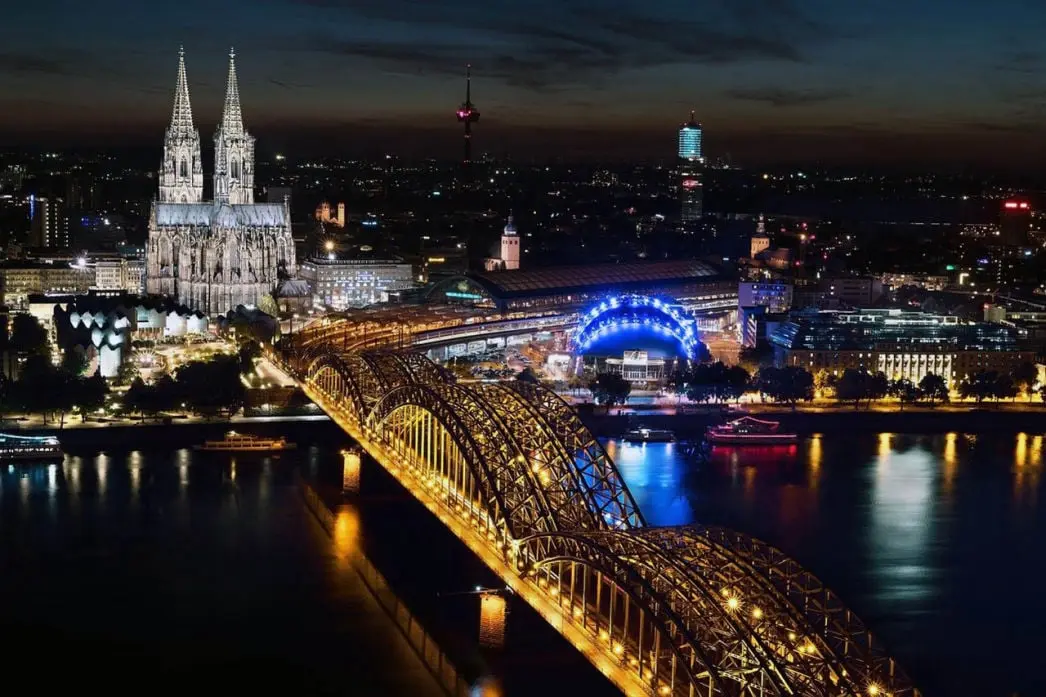
Audio file 2: Cologne Cathedral (part one)
The Cologne Cathedral, being visible from afar, is Cologne's landmark, and the city's focal point. After the Ulm Cathedral, the Cologne Cathedral, with its 157 meters in height, is considered the second tallest church in Germany and the third tallest house of worship in the world. The cathedral’s approximately 8,000 square meters of floor space can accommodate more than 20,000 people. In 1996, UNESCO declared the cathedral one of the greatest European masterpieces of Gothic architecture and a World Heritage Site.
Among devout Catholics, the Cologne Cathedral is considered as an important place of pilgrimage; after all, the bones of the Three Wise Men lie there. As early as the fourth century, a Christian sacred building stood on the site of today's cathedral. The first church building whose appearance is known was the Carolingian cathedral completed in 870. The foundation stone of the Gothic cathedral was laid on August 15, 1248, on the Feast of the Assumption. The old cathedral was apparently no longer representative enough to house the bones of the Three Wise Men, which Archbishop Rainald von Dassel had brought to the cathedral city from conquered Milan in 1164. These relics made the cathedral one of the most important pilgrimage sites in Europe. The mighty pair of towers has dominated the city’s panorama since its completion in 1880.
Now let's explore the second part of Cologne Cathedral with our audioguide.
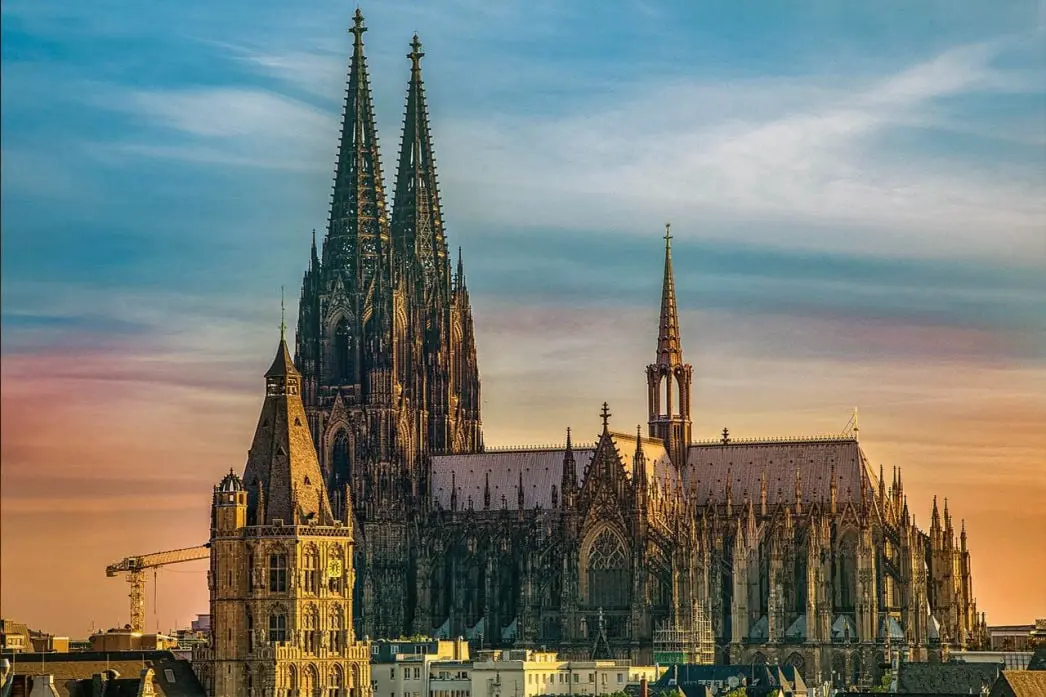
Cologne Cathedral ( part two)
The slender nave of the Cologne Cathedral, which leads to the choir room, is the longest nave in Germany at 144 meters and is accompanied by two side aisles.
In the crossing stands the modern bronze altar, which was created between 1960 and 1971 by the sculptor Elmar Hillebrand. Behind it is the choir stalls dating from 1308 to 1311, which with its 104 seats is one of the largest preserved medieval choir stalls in Germany and where separate seats were reserved for the pope and the emperor. Around 1340 the choir screen paintings were created, on which 21 narrative representations are depicted. Above them are older choir pillar sculptures of Jesus, Mary and the 12 apostles.
In the center of the choir head is the high altar, which was consecrated in honor of St. Paul the Apostle. Behind the high altar rises the Epiphany shrine, which, like a basilica, embodies the Trinity of God. This outstanding work of medieval goldsmith's art is 1.10 meters wide, 1.53 meters high, 2.20 meters long, as well as weighing 6 hundredweights and was made on the orders of Archbishop Phillip von Heinsberg in honor of the Three Wise Men. In addition, the bones of the saintly revered martyrs Felix, Nabor and possibly Gregory of Spoleto also rest here.
Every Cologne resident and even non-Cologne resident should have at least climbed the cathedral roof once. The way up is a bit tedious: to be able to climb to the roof of the cathedral with the audioguide, you must not be acrophobic and should be free of giddiness. The first queasy feelings might already arise in the elevator that takes visitors up to the platform at a height of 45 meters. Once at the top, however, you will be rewarded with breathtaking views.
Audio file 3: Historic City Hall
Next stop of this audioguide, the Cologne City Hall consists of two building parts, on the one hand the actual Historical City Hall and on the other hand the Spanish Building directly opposite.
The first documented mention of the city hall is as the "House of the Citizens" in the years between 1135 and 1152. After gaining the status of a free imperial city, the Cologne guilds had the town hall tower built.
The late Gothic tower, with its three square-shaped lower floors, and two octagonal upper stories, is adorned with no fewer than 130 stone statues. Not forgetting the famous "Platzjabbeck", a wood-carved grimace that opens its mouth and sticks out its tongue every time the tower clock strikes the hour. In 1569, master builder Wilhelm Vernukken erected the Renaissance porch, the so-called town hall arbor (Rathauslaube).
While the arbor was largely spared in World War II, the town hall tower was considerably damaged and almost completely burned out. The ruin became a sign of the Cologne citizen’s willingness to rebuild; as early as 1950, the Cologne craftsmen remembered their old guild tradition and initiated the "Bauhütte Rathausturm" (Town Hall tower’s builder’s hut) .
The Hansa Hall is considered the centerpiece of the Historic Cologne City Hall. During the Second World War, the room, which was built around 1330, also burned down completely and had to be extensively reconstructed.
By the way, the carillon in the tower of the Historic City Hall also plays Cologne sounds: several times a day, the bells ring the melodies of the Bläck Fööss, Jupp Schmitz, Jacques Offenbach, Karlheinz Stockhausen or other Cologne musicians.
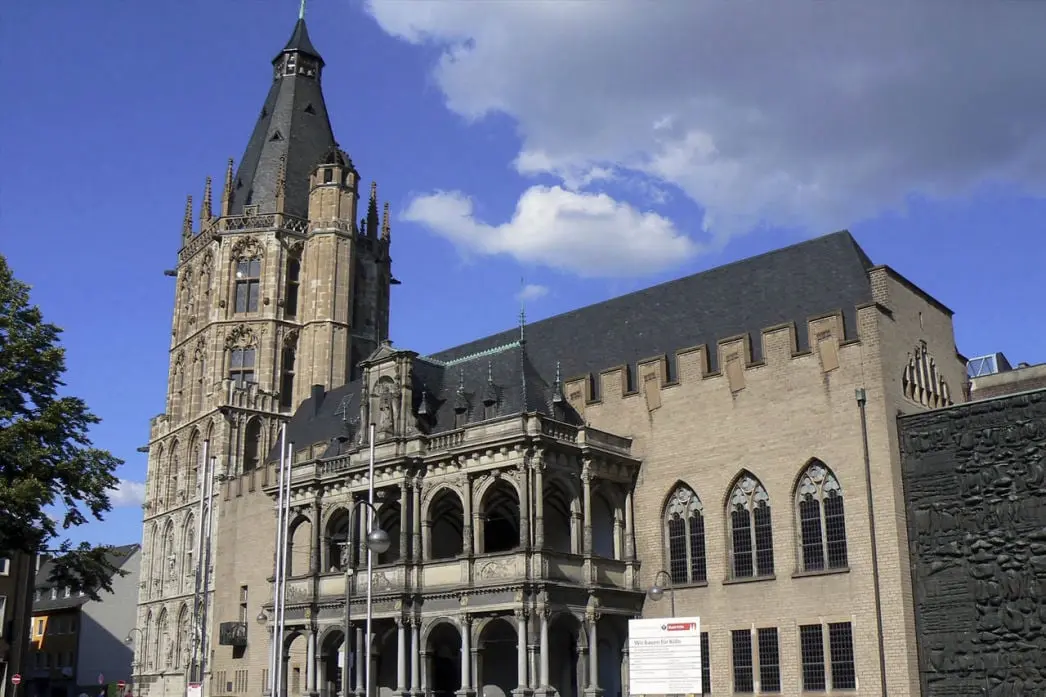
Audio file 4: Cologne Old Town
The area around the former Benedictine Abbey of St. Martin, the Alter Markt and the Heumarkt has always been a very lively quarter, wherein living, working, trading, pleasure, culture, religion, and tourism mixes.
Anyone walking through the Old Town with the audioguide should look very closely: stone grimaces with centimeter-long tusks adorn numerous house walls in Cologne's Old Town. There are various legends about the origin of these masks, which are also known as "grin heads" or "Anno heads" after Archbishop Anno. However, the most likely story is that a rod was inserted between the V-shaped downward tusks, which reached from the floor to a hole in the wall under the mask. With the help of a rope, a simple pulley could then be made over whereon goods could be pulled.
In addition, you will find flood marks on the walls of the houses, which testify to many historical floods. The current Rhine level can be read at the "Kölner Pegel" gauge tower.
There are other smaller squares and alleys in the old town and are worth a visit: the fish market and Jupp-Schmitz-Platz, for example. In addition to the Rhine promenade and the adjacent staple houses, the Heumarkt and Alter Markt are particularly popular and represent a central meeting point for Cologne residents and tourists, especially during the carnival and Christmas season. In addition, the Chocolate Museum, which is not only popular with children, is located on the Rhine and is described separately in our audio guide. Also, worth visiting is the 4711 Dufthaus (fragrance house), in whose fragrance museum the history of cologne can be experienced, and which talked about in the next audio of the audioguide.
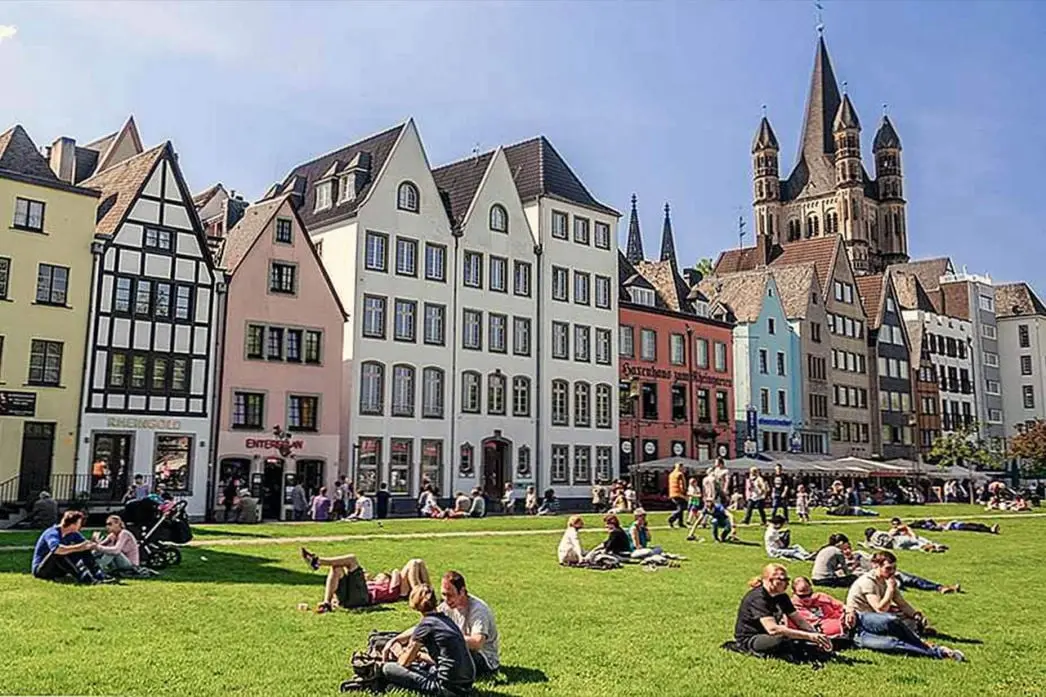
Audio file 5: 4711 Dufthaus
“4711 is one of the oldest and best-known brands in the world”, says Monika Hadrys. The manager of the traditional house in Glockengasse, together with her team of four saleswomen, welcomes around 60,000 customers a year in the building, which was rebuilt after being destroyed during World War II. The visitors come from all over the world - from Japan, China, Russia, India. The fragrance seminars, which Hadrys says are unique in Germany and allow participants to mix their own Eau de Cologne, are offered in several languages.
The world-famous brand owes its name 4711 to the French, who numbered Cologne's houses for better orientation during the French occupation in 1794. And the small factory of the merchant Mülhens was given the house number 4711, which was then also registered as a trademark in 1875.
According to legends, it was created by an Italian Carthusian monk named Farina, who gave the recipe to the merchant, Wilhelm Mülhens, as a gift for his wedding and promised that it would be an "aqua mirabilis" - a miracle water. Mülhens gratefully accepted the important gift and knew how to skillfully use it. Soon after his wedding he opened a factory in Glockengasse, Cologne, and sold the tincture as a health potion to be taken diluted with wine.
The main ingredients of the perfume are bergamot, lemon, orange, neroli, petitgrain, lavender and rosemary. Relaxing, calming, anti-inflammatory, stimulating, and analgesic - these effects are attributed to the perfume by the manager of the 4711 traditional house in Glockengasse.
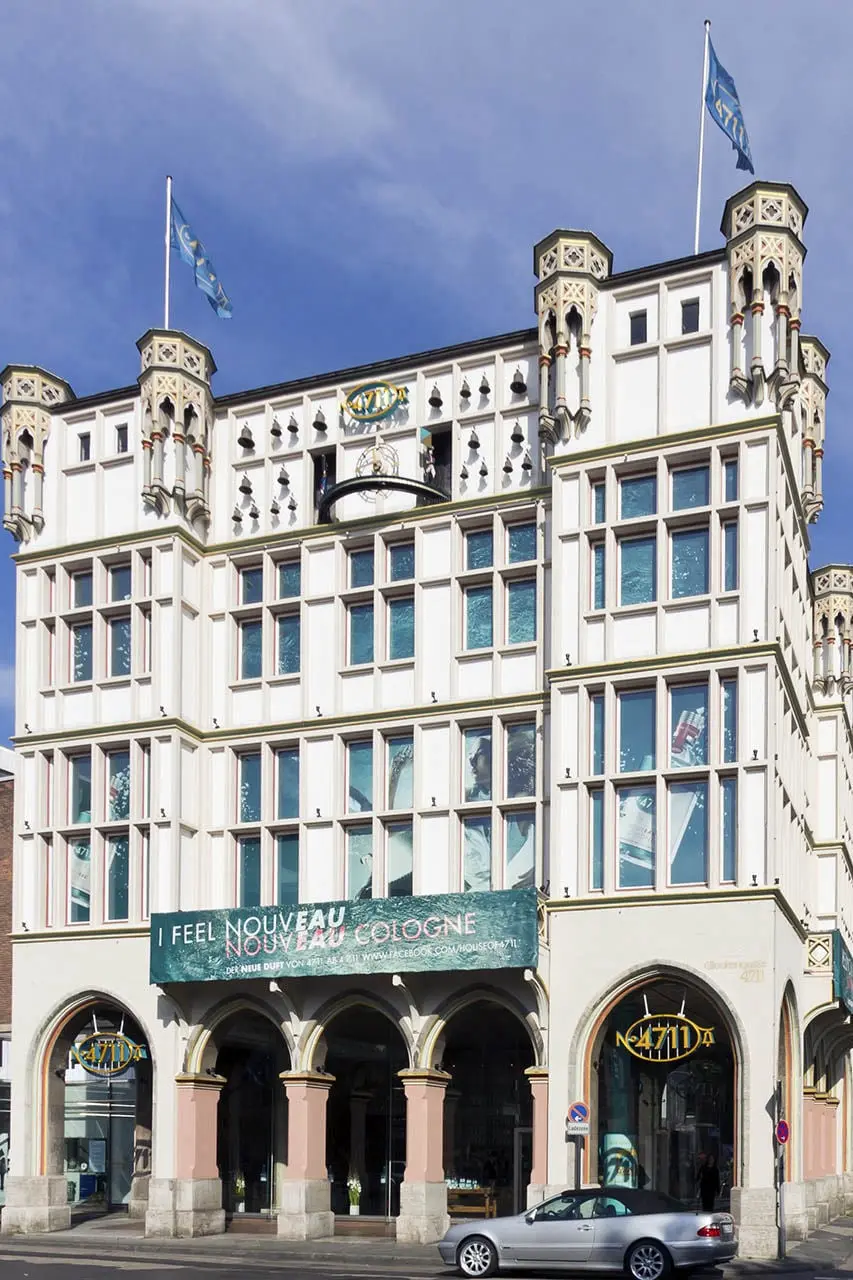
Audio file 6: Chocolate Museum
There is hardly a person who does not like chocolate - the preference for sweet things is in our genes. So, it is no surprise that the cultural history of chocolate is around 5,000 years old.
With over 650,000 visitors a year, the Chocolate Museum directly on the Rhine is Cologne's most-visited museum and one of the ten most-visited museums in Germany.
In the Chocolate Museum, visitors feel as though they were in a land of milk and honey: In the large, glass dome of the Chocolate Museum there is a large fountain from which only chocolate gushes. Visitors are permitted to savor the sweetness with small waffles.
The journey from the cocoa bean to chocolate is narrated. A short trip to the home of the cocoa bean can be made in the greenhouse. One focus is on the production of the brown delicacy, and visitors can also experience live how hollow shapes are made.
On the upper floors of the museum there are special exhibitions, but also fun articles about chocolate. After paying a visit to the Milka cow, for example, visitors can take a short break at the "Take a break - have a kitkat" bench.
Various show panels and computer-animated exhibition areas invite visitors to participate and try out the products. If you have not yet had enough of the sweet treat afterwards, you can buy something from the museum’s own store, which you can take home.
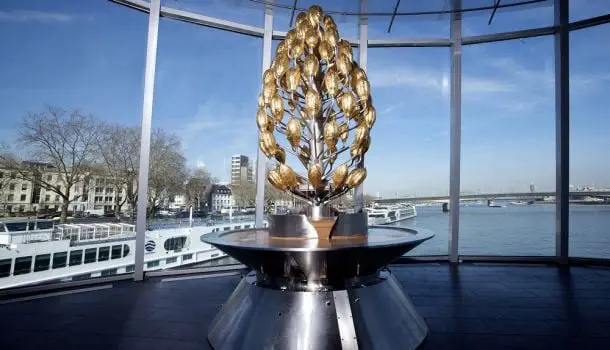
Audio file 7: Roman-Germanic Museum
Anyone who digs out the ground in Cologne will sooner or later come across Roman or medieval treasures. The Roman-Germanic Museum, which opened in 1946 and is centrally located in the shadow of the Cologne Cathedral on Roncalliplatz, draws on the archaeological heritage of the city and its surrounding area from prehistory to the early Middle Ages. Generations of schoolchildren from Cologne and the surrounding area have learned all about the history of the cathedral city here.
Being in the immediate vicinity of the Cologne Cathedral, the museum stands over the foundation walls of a Roman city villa with the world-famous Dionysus mosaic (c. 220/230 AD), which once adorned the floor of a distinguished dining hall. Visitors can see the mosaic from the cathedral plateau through the large panoramic window. The monumental, reconstructed tomb of the Roman legionary veteran Lucius Poblicius (c. 40 AD) can also be admired from there.
Other highlights of the museum, which you can explore with the audio guide, are the world's largest collection of Roman glassware and an outstanding collection of Roman and early medieval jewelry. Numerous findings relating to Roman everyday life, inscriptions, many portraits - including portraits of the imperial couple Augustus and Livia and the mother of the city's founder Agrippina the Elder - lead visitors right into the heart of the Roman colony “Colonia Claudia Ara Agrippinensium”, as Cologne used to be called.
The oldest exhibits in the Roman-Germanic Museum date back about 100,000 years; they allow conclusions to be drawn about the living habits of early men. The findings from the Stone, Bronze and Iron Ages come from Cologne, the Rhineland and selected European sites.
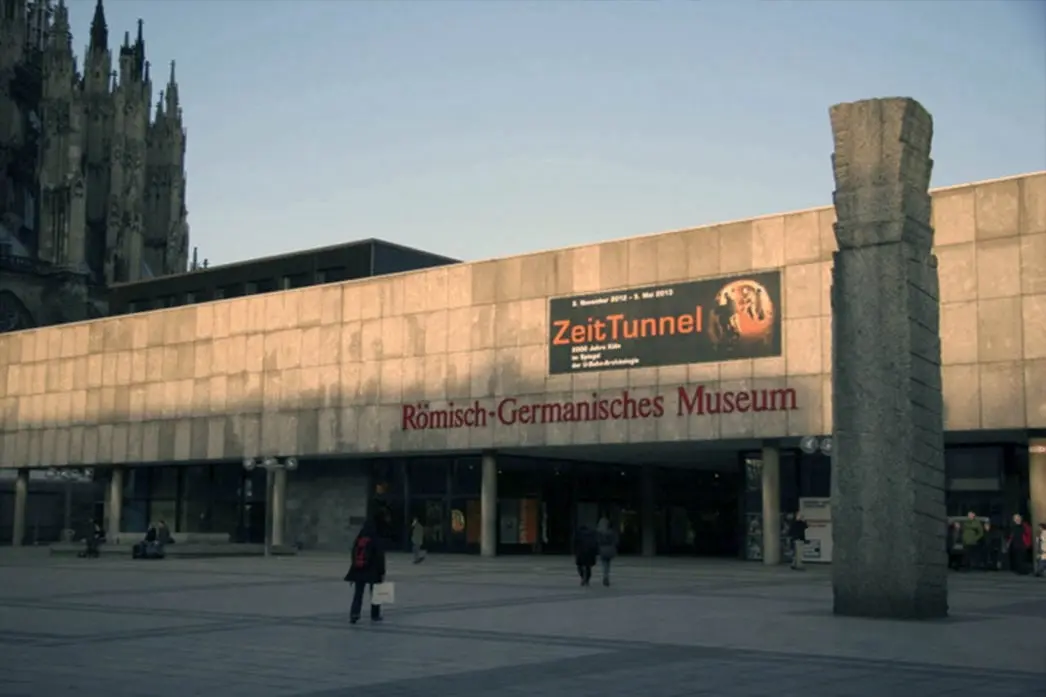
Audio file 8: Rhine Boulevard
The Rhine Boulevard at the Deutz Promenade invites visitors to linger on its riverside steps with the audioguide, drink a Kölsch or simply stroll along the Rhine. All with the best view of the Cologne Cathedral and the beautiful Old Town panorama.
The Rhine’s shore staircase has quickly become one of the city's hotspots since it opened in 2015. Especially during summer, countless people can be seen there enjoying the time – regardless of whether you are a genuine Cologne resident or a tourist, there is plenty of space here, as the 500-meter-long staircase offers seating for around 10,000 people. The materials chosen for the design of the Rhine Boulevard are light-colored exposed concrete, which is contrasted with dark precast concrete elements of the vertical back walls. Due to their uneven surface structure, these almost look like natural stones.
Thanks to its central location, the boulevard can be quickly reached from the main train station. It would be great if you walked past the cathedral, and over the Hohenzollern Bridge. Past the countless love locks, which will be talked more on in the next audio file of our audioguide.
In 2017, the Rhine Boulevard was even awarded the Landscape Architecture Prize.
Regardless of whether you are on foot or train, when you arrive at the "Schäl Sick", as the right shore of the Rhine is also called, you can enjoy the best view of the cathedral and are guaranteed to get a nice photo of the landmark.
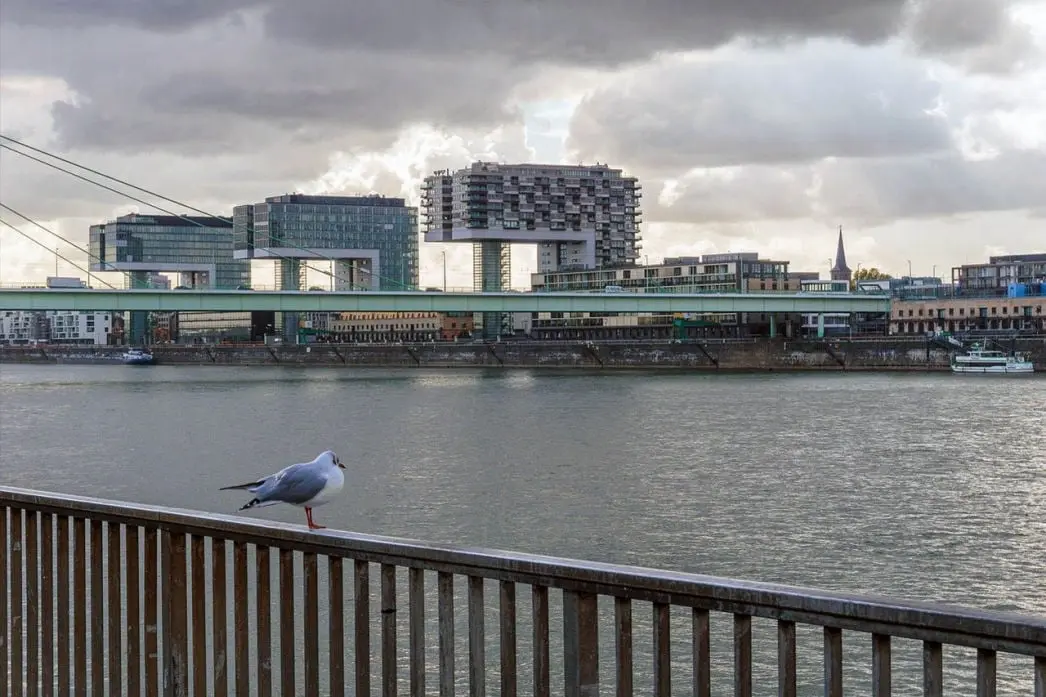
Audio file 9: Love locks at the Hohenzollern bridge
For several years now, there has been a custom in Cologne: couples in love label a small padlock with their name and the date and attach it to the railing of the Hohenzollern Bridge to swear their eternal love to each other in a very romantic manner. The two of them then traditionally throw the key into the Rhine together. Initially, the owner of the bridge, Deutsche Bahn, had decided to remove the numerous tokens of love because they allegedly put unnecessary strain on the bridge's structure. Ultimately, however, the company was persuaded by the numerous fans of the custom to leave the locks hanging there.
Today, the locks are part of Cologne's cityscape and are visited by thousands of tourists as a popular tourist attraction that is worth mentioning in this audioguide. The exact origin of the tradition is unclear. The starting point in Europe is probably Italy. For a long time, it has been the custom of young lovers in the city of Rome to attach a padlock to the central bridge lantern of the Milvian Bridge and then throw the key into the Tiber River with the vow "per sempre", meaning forever.
The biggest problem is to find a free space for your own love lock, because now thousands upon thousands of love locks are hanging on the bridge, which makes it a touristic attraction. There are numerous estimates and calculations about how many love locks have already been attached, ranging from at least 150,000 to half a million (as of December 2020).
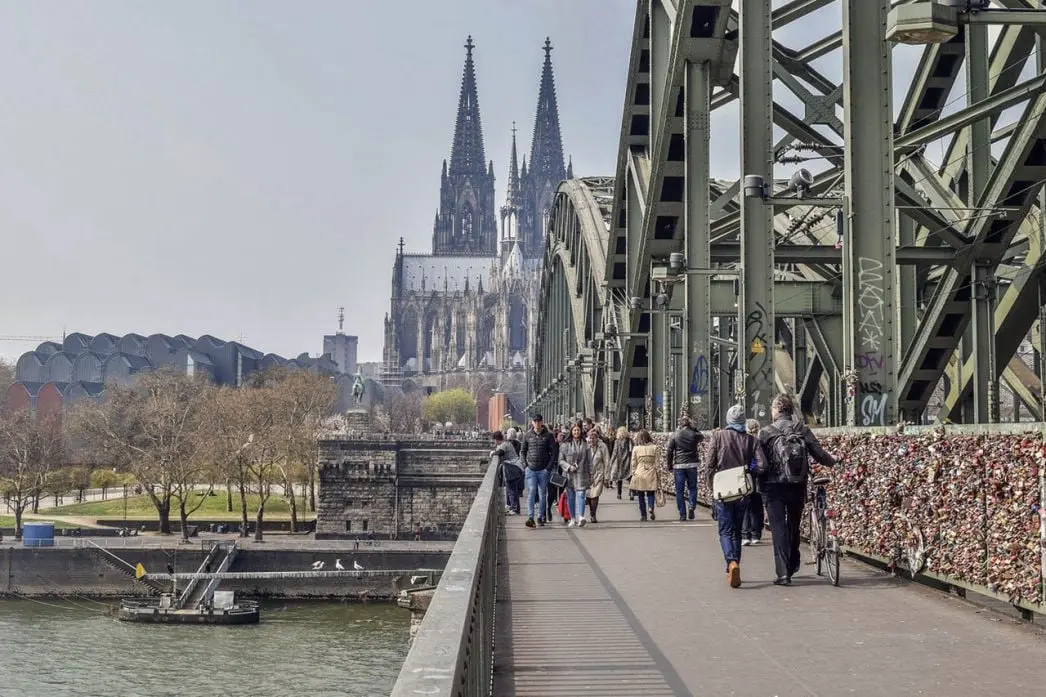
Audio file 10: Cologne Cable Car
This idea was born on July 21, 1955: On the event of the Federal Garden Show, Cologne was to get a larger cabin cable car in addition to the existing chairlift. And after two years of planning and construction, the time had come: on April 17, 1957, Cologne's mayor at the time, Theo Burauen, together with zoo director Wilhelm Windecken, opened the city's new attraction on the Rhine. Since then, visitors have been able to experience the fascination of floating high above the Rhine enjoying the splendid view of Cologne's panorama.
The approximately 6-minute ride high above the Rhine offers a great view of the city. More than 500,000 passengers take this 930-meter-long ride every year and enjoy the unique ride to the fullest. The total of 44 gondolas travel at a speed of ten kilometers per hour. At the highest point, the cabins are a solid 50 meters above the Rhine. Each cabin offers four seats, making the ride ideal for a joint family outing or a leisure trip with friends.
As a connection between the Rhine Park on the right shore of the Rhine and the Cologne Zoo on the left shore, which we will discuss in more detail in the next station of the audioguide, the Cologne cable car is a great opportunity to combine a visit to the zoo with a subsequent walk along the Rhine. Every day from 10 a.m. to 6 p.m., passengers in the gondolas can enjoy the fascinating view of the city panorama and the mighty river far below them. The ride can be started on either side of the Rhine.
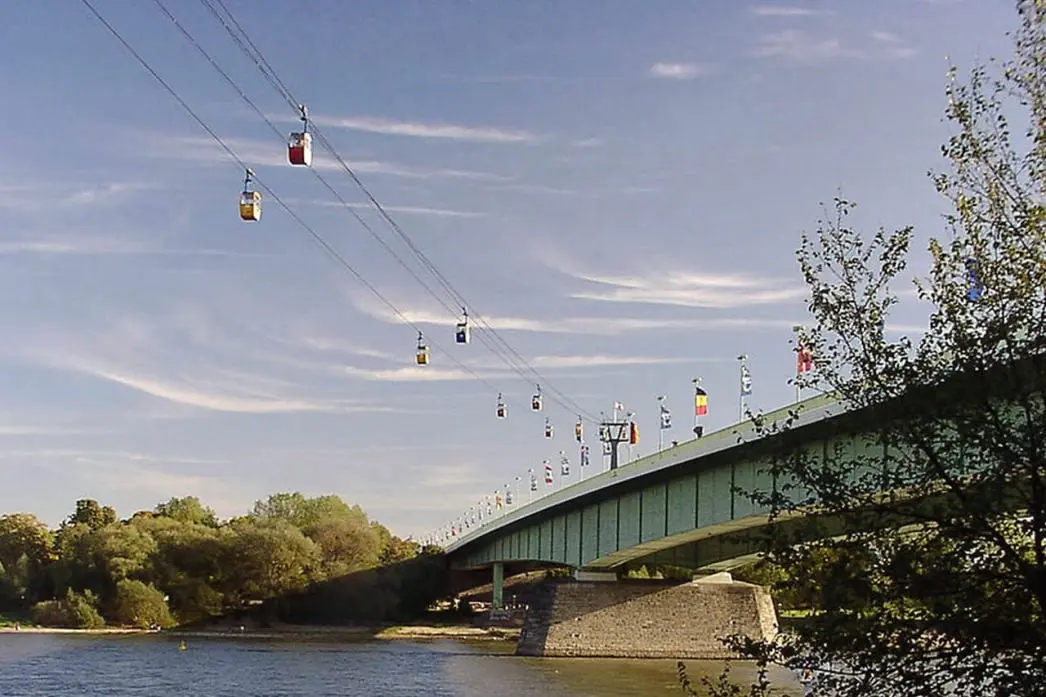
Audio file 11: Cologne Zoo
Next stop of the audioguide, founded in 1860, the Cologne Zoo is the third oldest zoo in Germany. The combination of old buildings, some of which date back to the founding years after 1860, and new buildings is what gives the zoo its special charm. It houses more than 700 animal species from all continents and oceans on an area of about 20 hectares. In the various enclosures and aquariums, the animals are presented to visitors in an environment adapted to their natural habitat.
In the rainforest, a real piece of Southeast Asian tropical forest has been recreated on 2,000 square meters, with free-flying birds and flying foxes, as well as reptiles and a variety of tropical plants. In the adjacent elephant park, the largest of its kind north of the Alps, up to 20 elephants can live and breed in their natural social group.
The Hippodom provides zoo visitors with spectacular underwater views of hippos and Nile crocodiles. Through large windowpanes, the pachyderms can be observed underwater at close range. The replica of an African river landscape is home to around 100 animals, including birds, fish, flying foxes and antelopes.
Since August 2014, the zoo has been home to an incredibly special guest - the mascot of 1. FC Köln, Hennes the VIII. In his very own "clubhouse," he may and can be marveled at alongside his fellow animals - unless FC Köln has a home game to play, in which case he makes his usual trip to the RheinEnergieSTADION.
Children particularly enjoy the baboon rock; mothers love the cute meerkats; and fathers particularly appreciate the gorillas. Zoo director, Theo Pargel, is not only a real animal fan, but he is also a lover of cars: in fact, he drives Schimanski's dented crime scene Citroën.

Audio file 12: Flora - Botanical Garden
Right next to the Cologne Zoo is the Flora, the city's botanical garden, which you can explore via the audio guide. With its more than 10,000 plant species, some of which are exotic, and its beautifully designed parks, the Flora is a green oasis in the hustle and bustle of the big city that invites you to stroll and relax.
After the old botanical garden had to give way for the construction of the main train station in the mid-19th century, a few Cologne entrepreneurs set themselves the goal of creating a new garden just outside the city limits of the time. The grounds located between the villages of Riehl and Nippes, which were still independent at the time, were designed by Prussian landscape architect, Peter Joseph Lenné, and opened in 1864. In 1920, the Flora was combined with the municipal botanical garden, and since then, entry into both has been free.
The Cologne Flora offers a rich array of partly exotic plants, small ponds, and winding gardens. There is even a waterfall. Giant trees such as an American sequoia stand right next to native, European- and Asian plants, making the park a paradise for birds and squirrels as well. Information boards inform the visitor about the different plant species.
In addition to Germany's first palm avenue, which was created in 2008, the rose gardens and the four interconnected show greenhouses are particularly fascinating. The latter are home to around 5,000 plant species in a small area, ranging from tropical crops and jungle plants to plants from desert areas and the subtropics. If you like palm trees and cacti or simply the sultry climate of the tropics, the Flora is the right place for you.
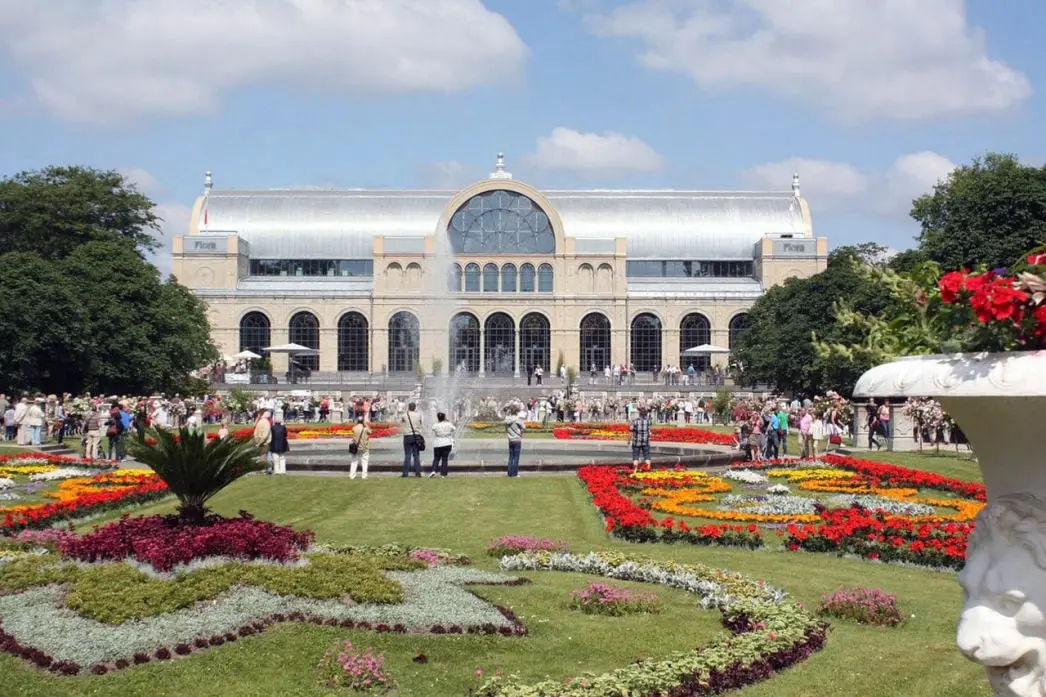
Audio file 13: TimeRide - Virtual time travel through old Cologne
TimeRide sends its visitors on a time travel through old Cologne in a true-to-the-original streetcar and is one of the most popular sights and leisure events in the cathedral city. Situated in the middle of the old town, Cologne's city-historical attraction takes you back to life of around 1900 in the cathedral city.
Twelve stereoscopic 3D photographs show the city of Cologne then and now. The hotspots on display are the Rhine panorama, the old town, the cathedral bridge, the main train station, Hohe Straße and Alter Markt.
As a next stop with the audioguide, the visitor enters a small cinema room, where there is a 15-minute film about the history of Cologne. In addition, a cinematic introduction to the virtual ride on the historic light rail will be shown.
Finally, as a highlight, the time travelers board a replica of the first electric streetcar and experience a virtual tour of the old town over 100 years ago. By putting on the VR glasses, passengers find themselves in the old tram directly behind a driver speaking in the Cologne dialect.
At a virtual speed of eight kilometers per hour, the tram starts at Rheingasse. The approximately 15-minute tram ride takes passengers along Frankenwerft and Bischofsgartenstraße, to Bechergasse and on to Alter Markt. Passengers enjoy a 360-degree panoramic view of Cologne and can observe the hustle and bustle of the city "in real time" on the right, left, above and below. Thanks to haptic feedback systems, such as tram vibration and airflow, the tram ride feels particularly authentic.
For the virtual tram ride to the Cologne of a hundred years ago, 600 houses of the old town were reconstructed according to historical sources. 3,000 animated figures fill the historical scenery with life and tell little everyday stories from back then.
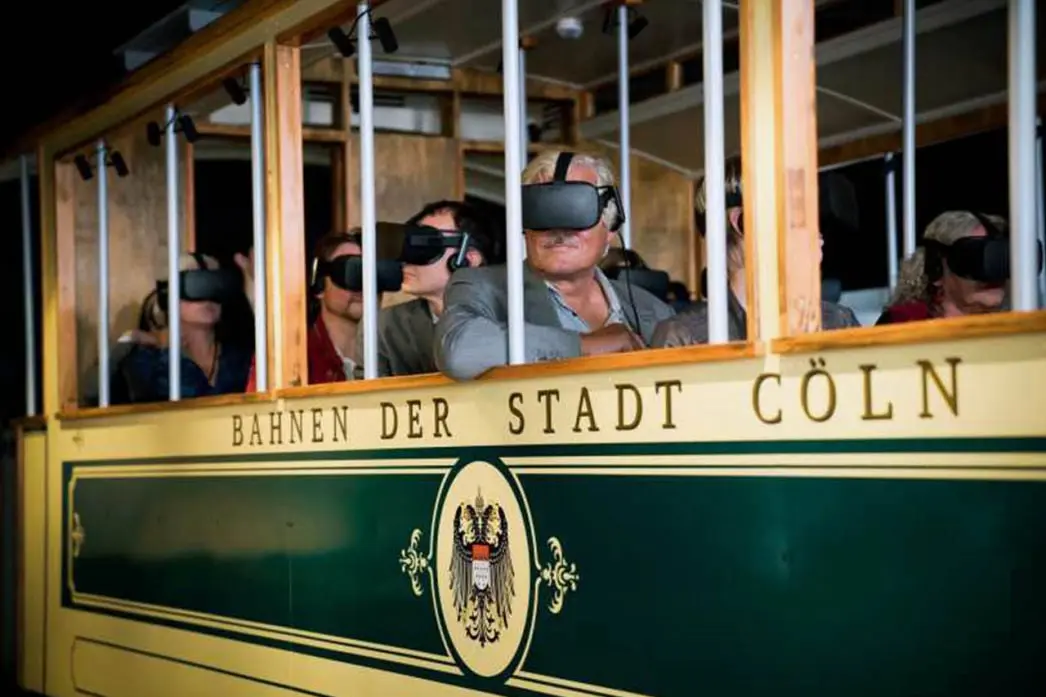
Audio file 14: Volksgarten
Next interesting place of this audioguide, the Volksgarten (or public garden) is one of the oldest parks in the city: since 1890, the park has existed on the site of the former Fort IV, parts of which is still preserved at the edge of the park. With its 5.5-hectare lake, beer garden, and interesting green design, it is still a popular meeting place for both young and old.
The Volksgarten is not only one of the most beautiful parks in the city, but also has something to offer everyone. The large lake, for example, invites you to take a pedal boat trip; and in the Hellers beer garden, located directly on the lake under impressive pastures, the Kölsch tastes twice as good. The main attractions include a rock garden and the large pond in the park with a 28-meter fountain.
Behind high walls lies the old orangery with two attached glass houses. The building got its name because frost-sensitive plants were housed there after World War II. Today, concerts, films and plays are staged in the Orangery with its distinctive ambience.
For children there is a gigantic playground and young people can relax or have a barbecue on the extensive lawn. Those who prefer a quieter milieu can retreat to the tranquil rose garden within the walls of the old Fort IV - it is rare for anyone to stray here, and peace and quiet is guaranteed even when joggers are jugging outside on the paths.
Make an appointment with friends on a hot summer day for a Kölsch beer and a pedal boat tour, and then take an extensive sunbath on the lawn!
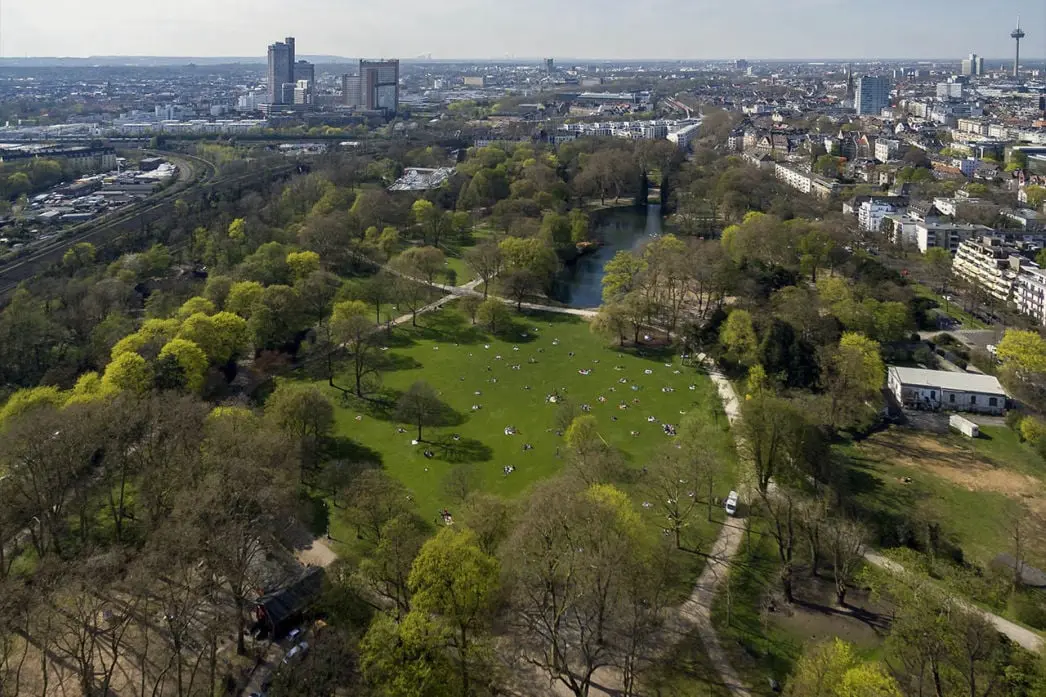
Audio file 15: Brewery tour
On one of the offered brewery-tours you will go on an entertaining walk through the old town of Cologne. With the help of the audio guide, you will learn a lot about Cologne, as well as about Kölsch beer, and visit selected breweries where you can savor the delicious top-fermented beer.
The tour starts at the city's most imposing building: Cologne Cathedral, which has been described in more detail in the first audio file. After that, you will head to the old town, as a variety of historic breweries await you here. Afterwards you will know why the Kölsch is so much better than Altbier, and what exactly Köbes, Kranz, Pittermännchen and Halve Hahn mean.
During the brewery tour you will get an authentic impression of the Rhenish mentality and Kölsch culture. In addition, the audio guide will tell you one or two anecdotes. In a humorous way, you will also learn where the differences and similarities between Kölsch, Alt and Pils lie.
Also, on this tour, it is particularly important that you learn the correct drinking behavior while savoring the different Kölsch varieties! So, use the tour as the start of an unforgettable evening, and visit other breweries thereafter, on the recommendation of your tour guide.
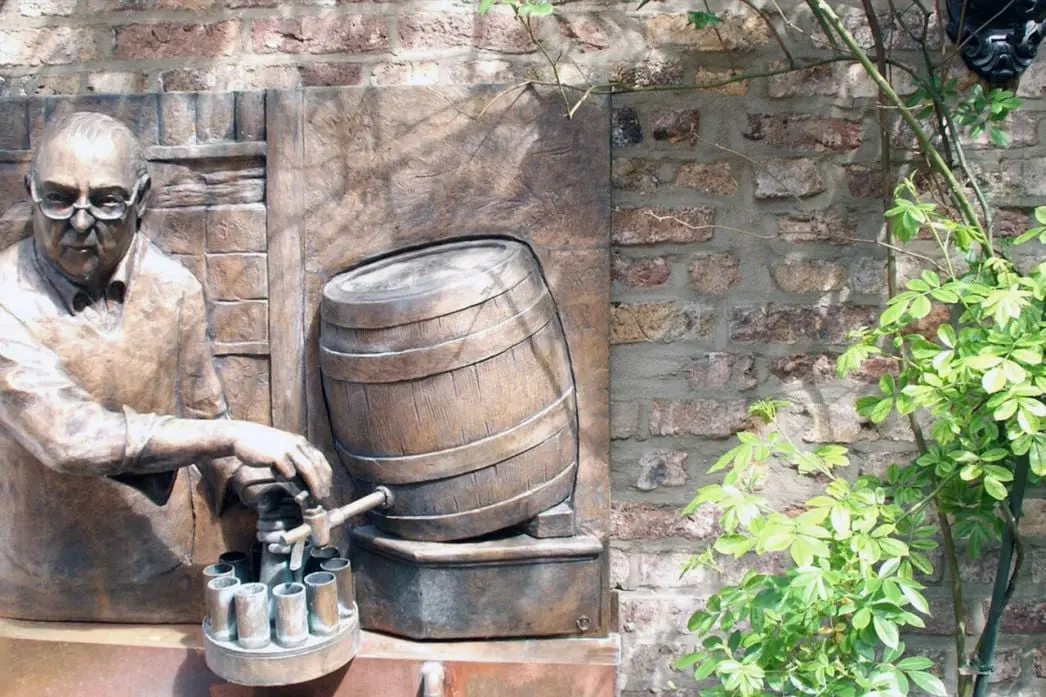
Audio File 16: The Lommerzheim (Cologne most typical pub)
If you ask about the traditional Kölsch pub par excellence, you will inevitably end up at the Lommerzheim. The pub in the Deutz district with its rustic facade is so well known that tourists from all over the world have it on their itinerary. Locals are, however, the majority therein- despite the numerous visitors from abroad, the people of Cologne still love their "Lommi", especially because of its former cult host, Hans Lommerzheim, (he died in 2005), who denied the then U.S. President Bill Clinton entry with a profane "No, you can't", because his regulars would have had to stay outside due to the impending security precautions.
While the historic taproom remains unchanged, the pub has been enlarged downstairs and to the side. A two-room vaulted cellar promises a rustic atmosphere, while the new beer garden offers drinks under the open Rhenish sky.
The Lommerzheim is hardly less famous for its oversized chops, which are served with braised onions and French fries or fried potatoes. Other hearty Cologne dishes such as warm meat sausage with potato salad or bratwurst are also on the menu card. The focus, however, is less on the food and more on the consumption of Päffgen-Kölsch from the house brewery of the same name, which is exclusively drawn from the barrel.
Amusement continues in the next section of our audioguide!
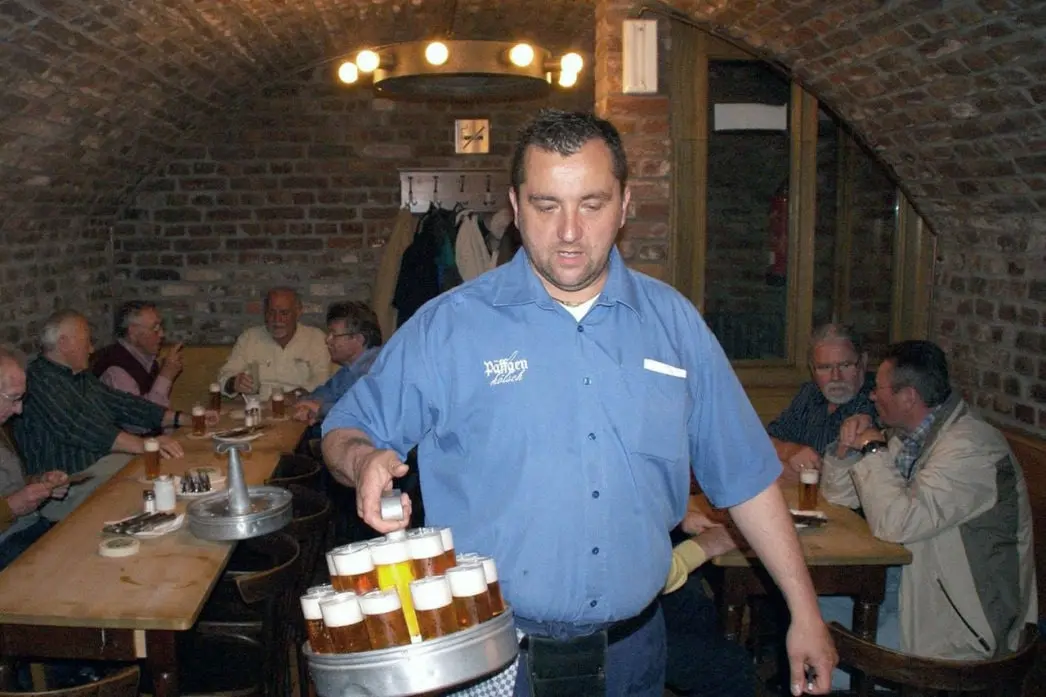
Audio File 17: Carnival Museum
The city of Cologne is irrevocably linked to the fifth season of the year, because the Carnival in the Rhenish city attracts more than one million visitors every year; in addition, there are around 200 Cologne carnival societies and clubs, 500 meetings and events, and 12,000 participants in the Cologne Rose Monday parade. Yet the events are more than just organized merriment; they are more in keeping with the unadulterated nature of the Cologne revelers. The Cologne Carnival Museum, also known as the KK Museum, is the largest of its kind in the German-speaking world. It presents the tradition of the mad hustle and bustle of the city of Cologne and other regions, arranged thematically and chronologically.
The roots of the Cologne Carnival go back to antiquity. Accordingly, there is a lot of history to marvel at in the 1400 sqm area, which you can explore with the audio guide.
The era of the Middle Ages, the Baroque, as well as the Weimar Republic and National Socialism are critically examined in the context of the carnival. In addition, countless exhibits such as traditional uniforms as well as magnificent medals and caps bear witness to the tradition of carnival and its cultural significance for the people of Cologne. Extensive historical documents and writings could be secured for the museum and exhibited together with prints. The most valuable exhibit is probably the minute book of the "Festordnende Comitee" from 1827.
Thanks to an impressive staging and with the help of the audio guide, you will be right in the middle of the colorful hustle and bustle of the Cologne street carnival and gain an impression of the enthusiasm that the Cologne carnival triggers anew every year.
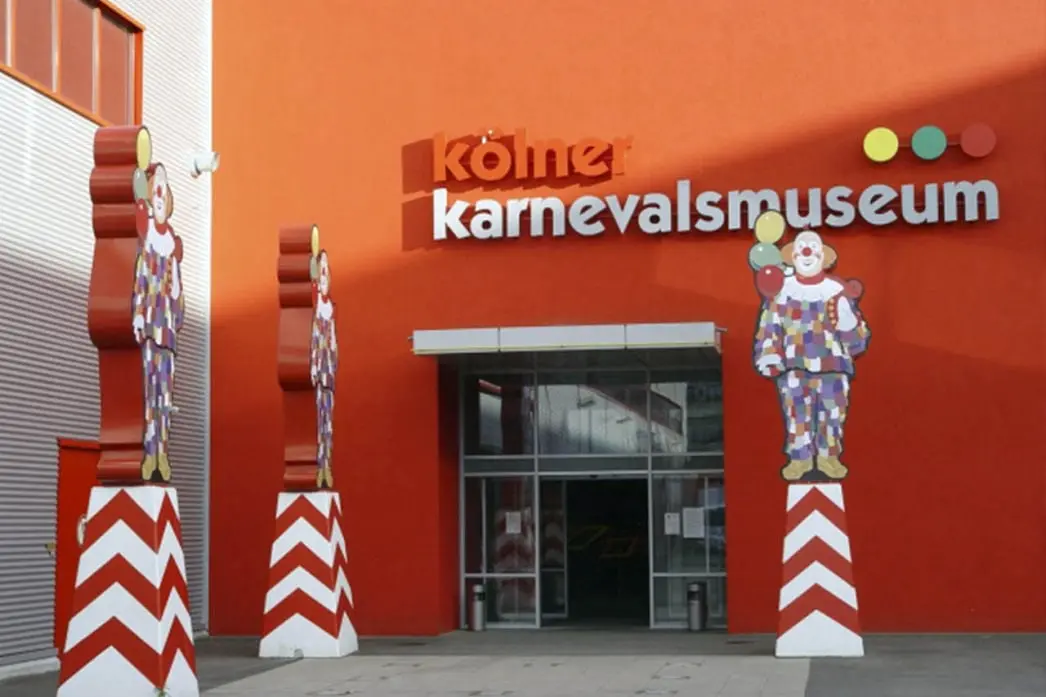
Audio file 18: Tram museum
Railroad enthusiasts will get their money's worth at the Thielenbruch Tram Museum. On more than 2,500 square meters, the tram museum presents 20 historic Cologne trams. In addition, you will come across historic tickets, conductor's bags, posters, and advertising materials of the time.
With the audio guide, you will enter this museum according to the theme through an old tram car integrated into the masonry. The entrance hall, which is used as a restaurant, leads you to the huge exhibition hall, which served as the car depot for the Thielenbruch depot from 1905. On more than 2,500 square meters, 20 historic Cologne trams are presented here.
In the entrance area, several glass showcases that contain original handicrafts will catch the eye: Using photos, cardboard, scissors and glue, model worlds of contemporary Cologne train stations were created. From here, one of the real treasures of this museum immediately catches the eye, the horse-drawn carriage 211 from 1894. For thirty years, public passenger transportation was carried out by the so-called "Päädsbahn", starting on May 20, 1877 on the Kalk-Deutz line.
Right next door is car 407 which is a model of Cologne's first electric tram. Introduced in 1901, the city already had 371 of this type seven years later. Since no originals have survived, the 407 was modeled from a Bonn railcar built in 1902. There was room for a maximum of 16 passengers on the two opposite longitudinal benches, but then it also got tight, which is why “ladies with unprotected hatpins”, unfortunately had to stay outside, as the transport regulations stipulated.
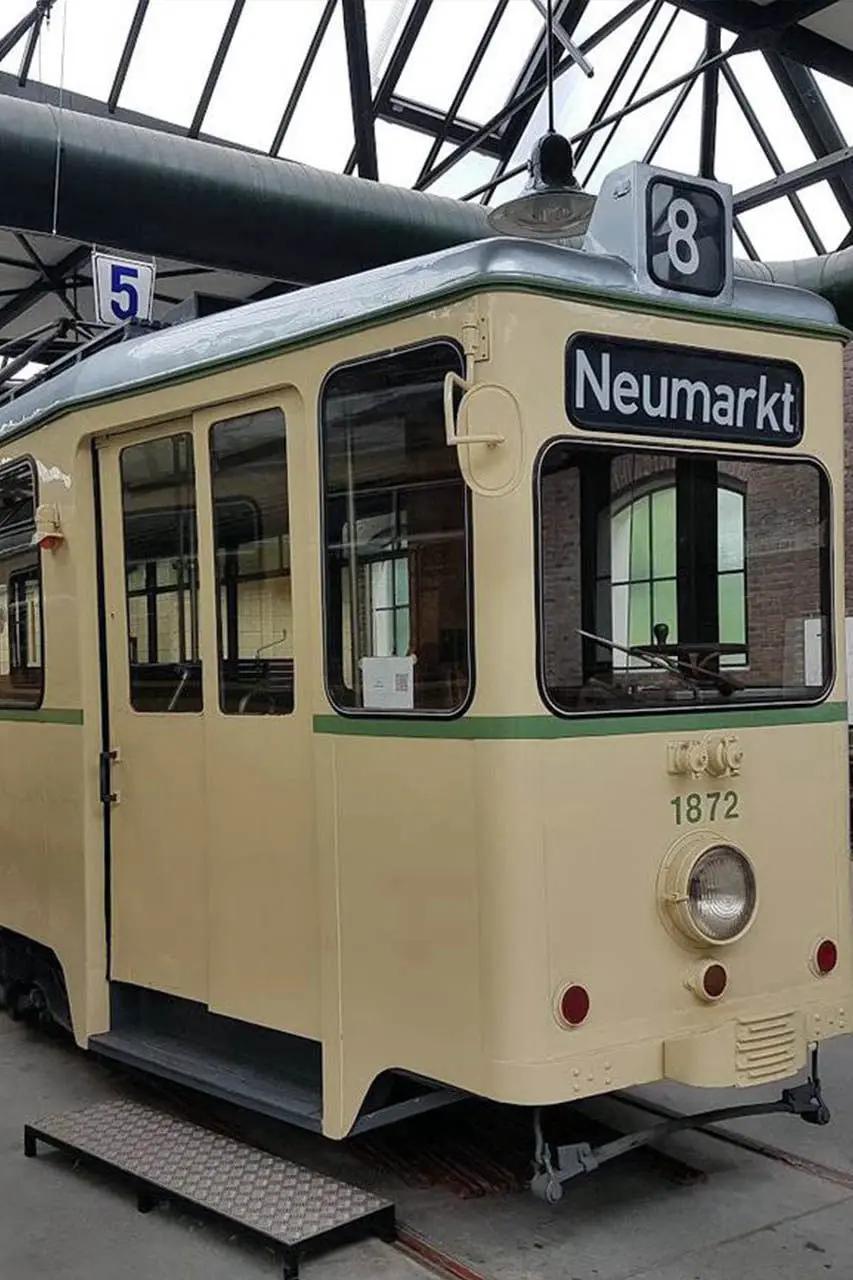
Audio file 19: House X1 - Cologne's most unusual residential building
It is not without a certain irony that the street wherein Cologne's most unusual house stands is called "Am Zehnpfennigshof" or House of 10 cents. After all, the houses adjoining it cannot be bought for less than a few million euros. This also applies to “Haus X1”, which attracts attention thanks to its extremely unusual architecture.
All the houses on Am Zehnpfennigshof are large, and quite a few were obviously designed by ambitious architects. One of them, however, house number 9, is particularly eye-catching.
The house, named X1, was built between 1959 and 1962 by the architect Peter Neufert. Born in Saxony-Anhalt, he mainly worked in Cologne and the surrounding area. In the city area, he was responsible for the residential and commercial building at Weyerstrasse 43-45 and the office building at Aachener Strasse 1030-33, among others.
The two-story building is spanned by a light blue reinforced concrete shell that reaches almost to the ground at the sides before rising slightly again. The facade, on the other hand, has a deep red coloration. Cubes of different sizes jump back and forth, with windows and balconies occupying the spaces in between. Depending on the perspective, this building sometimes resembles a hangar, sometimes a mushroom. To the rear is a spacious pool complimented with diving board, which - not necessarily typical for the area - is freely visible from the street. In contrast to the front, the garden side of the house was completely glazed.
We hope you enjoyed Cologne with the audioguide! See you soon!
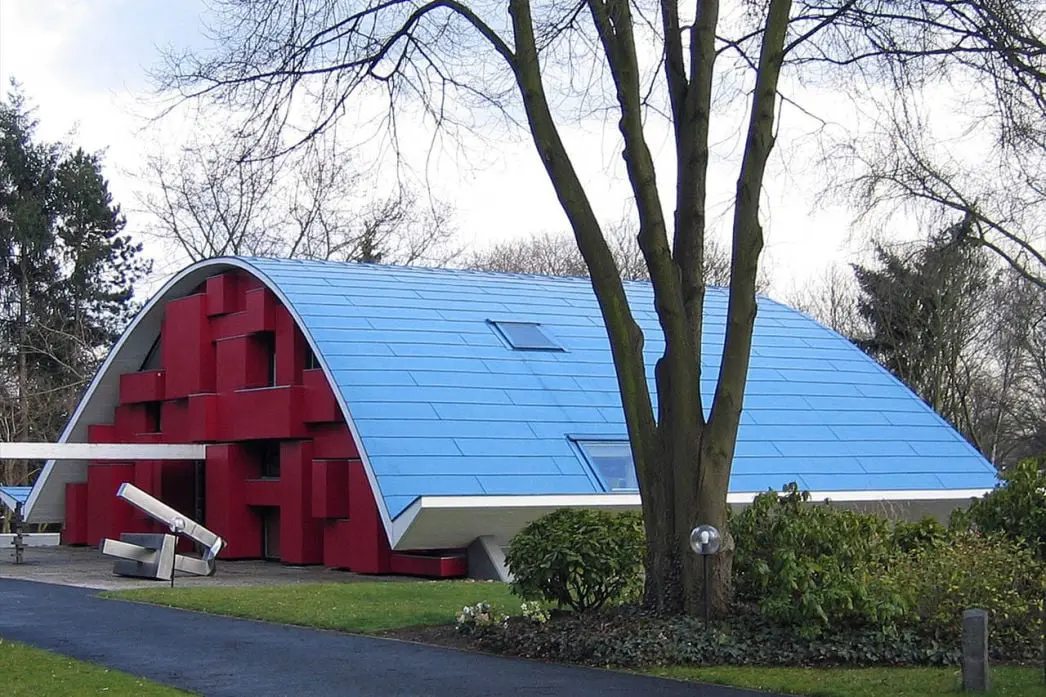
Audio guide devices, Multimedia audio guides,
Audio guide GPS tourist bus-train, charging bases and accessories.
Group guidance systems, headsets, charging cases, tour guide systems accessories.
Audioguides available from mobile devices, web App, downloadable App from Google Store.
Audioguides in several languages, translations, voiceovers. Audio descriptions, signoguides, visual contents for audioguides. 3D Reality.